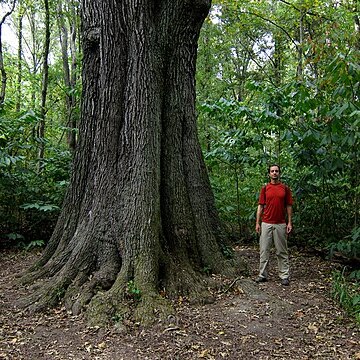Trees , deciduous, to 40 m. Bark nearly black with narrow and noticeably flaky ridges, often resembling that of wild black cherry, inner bark orange. Twigs yellowish brown, 2-3.5 mm diam., pubescent. Terminal buds light reddish brown, ovoid, 4-9 mm, strongly 5-angled in cross section, puberulent throughout. Leaves: petiole 20-50 mm, glabrate or pubescent. Leaf blade ovate to elliptic or obovate, 90-300 × 60-160 mm, base cuneate to rounded or truncate, margins with 5-11 lobes and 10-25 awns, lobes oblong, rarely falcate, terminal lobe rarely exceeding lateral lobes in length, apex acute; surfaces abaxially pale, tomentose, adaxially glossy, glabrous, secondary veins raised on both surfaces. Acorns biennial; cup saucer-shaped to cup-shaped, 3-7 mm high × 10-18 mm wide, covering 1/3-1/2 nut, outer surface puberulent, inner surface pubescent, scale tips tightly appressed, acute; nut subglobose, 9-15 × 8-16 mm, often striate, puberulent, scar diam. 5-9 mm.
More
Large tree, to 30(–35) m; bark of middle-sized trunks with numerous small, flat plates, much as in Prunus serotina, at full maturity finely multiridged and-furrowed; lvs more regularly and uniformly lobed than in no. 22 [Quercus falcata Michx.], the middle lobes usually with short, widely spreading upper edge and longer, more tapering lower edge, the terminal lobe relatively short and broad, often tapering from the base, not falcate; otherwise much like no. 22 [Quercus falcata Michx.] Typically in bottomland hardwood forests; s. N.J. to Ga., nw. Fla., and e. Tex. mainly on the coastal plain, and up the Mississippi embayment to w. Ky. and s. Ind. (Q. falcata var. pagodaefolia)


